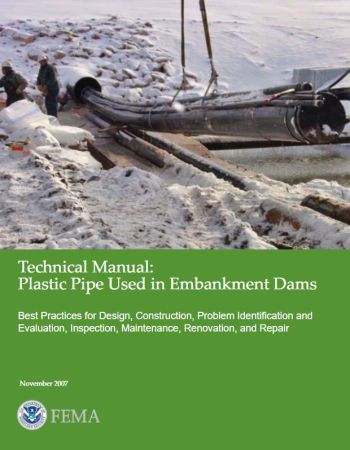Technical Manual: Plastic Pipe Used in Embankment Dams (FEMA P-675)
Federal Emergency Management Agency, 2007

Plastic pipe is lightweight, abrasion resistant, and inert to most forms of chemical attack. This facilitates installation and benefits durability and service life. Plastic pipe is often used in toe drain systems for collecting and measuring seepage and safely discharging it into a channel located downstream from the dam. Plastic pipe is commonly used for toe drain construction, since it is relatively inexpensive, readily available in many diameters, can be manufactured with slots or perforations, and can be rapidly installed. Another frequent use of plastic pipe is for the sliplining of deteriorating outlet works conduits. Plastic pipe is preferred for sliplining due to its ease of installation, ability to re-establish the watertightness of the conduit, and improved hydraulic performance.
Plastic pipe has been used for many decades in water and sewer applications. More recently, plastic pipe has been used in new embankment dam construction and in the renovation of existing conduits. However, most of the available design information is targeted toward water distribution and sewer pipes and does not address the unique factors involved in using plastic pipe in embankment dams. In general, information on plastic pipe is too dispersed for the best use of lessons learned from past performance, and compilation of information into a more readily available source was needed. Due to the absence of any single recognized standard for plastic pipe used in embankment dams, there is significant inconsistency in the design and construction rationale. In an effort to deal with this problem, this document has been prepared to collect and disseminate information and experience that is current and has a technical consensus. The goal of this document is to provide a single, nationally recognized standard to promote greater consistency between similar project designs, facilitate more effective and consistent review of proposed designs, and result in increased potential for safer, more reliable facilities.
Revision ID: 5844
Revision Date: 12/16/2022
